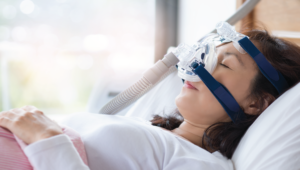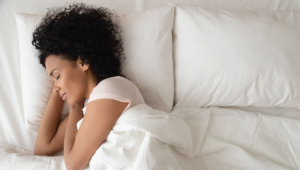Urinary Tract Infections (UTIs) can cause significant discomfort, making it difficult for sufferers to get a good night’s sleep. Common symptoms, such as pelvic pain and the frequent urge to urinate, can keep a person awake and restless throughout the night.
There are various strategies to help relieve nighttime UTI discomfort and improve sleep quality for individuals experiencing this condition. By implementing specific medical and home remedies, one can find relief and sleep more soundly, despite the challenges posed by a UTI.
Understanding UTI Discomfort
Urinary Tract Infection: Causes and Symptoms
A Urinary Tract Infection (UTI) occurs when bacteria invade any part of the urinary system, including the kidneys, ureters, bladder, and urethra. UTIs are more common in women, but men can also suffer from them. The most common symptoms include:
- Pain or burning during urination
- Frequent urge to urinate
- Lower abdominal discomfort
Anatomy of the Urinary System
The urinary system consists of the kidneys, ureters, bladder, and urethra. The primary function of the urinary system is to filter waste and excess water from the blood, creating urine. The kidneys produce urine, which then travels through the ureters to the bladder. The bladder stores the urine until it is expelled from the body through the urethra.
Urinary tract infections typically affect the lower urinary tract, involving the bladder and urethra. However, if left untreated, However, a UTI can lead to a more severe kidney infection if left untreated. Understanding the anatomy of the urinary system and the causes of UTIs can help individuals better manage discomfort and seek appropriate treatment.
Managing UTI Discomfort for Better Sleep
Lifestyle Changes and Home Remedies
One effective way to manage UTI discomfort is by adopting lifestyle changes and using home remedies. Drinking plenty of water can help flush out the infection and reduce the urge to urinate. However, reducing fluid intake in the evening is advisable to minimize nighttime incontinence.
Applying a hot water bottle or heating pad to the lower abdomen may help to alleviate bladder discomfort. A warm bath with baking soda can also relieve pain, inflammation, and itching associated with UTIs. Try to avoid caffeinated, acidic, or carbonated drinks, as they can worsen bladder irritation.
Medications and Pain Relief Options
When it comes to medications for UTI pain relief, antibiotics are the primary treatment option. They target the underlying infection, and the symptoms typically take 1-2 days to improve. Over-the-counter pain relievers like acetaminophen and ibuprofen may be used for temporary relief.
For more targeted relief, phenazopyridine (available as Azo-Standard or Pyridium) can be taken to address burning sensations and bladder spasms. It is essential to consult your healthcare provider before trying any new medications or over-the-counter treatments to ensure their safety and efficacy for your situation.
In addition to these measures, consider using incontinence pads or absorbent briefs to manage frequent urination and protect your sleep quality. By combining these strategies, UTI discomfort can be effectively managed for better sleep and overall well-being.
Foods and Drinks to Avoid
Dietary Impact on UTI and Sleep
When experiencing UTI discomfort, it’s important to monitor one’s diet. Certain foods and drinks are known to irritate the bladder and worsen UTI symptoms, which impact sleep quality.
Alcohol and Caffeine: Both alcohol and caffeine can dehydrate and irritate the bladder. Consider reducing the intake of coffee, tea, and carbonated drinks.
Spicy and Acidic Foods: Spicy foods and acidic fruits like tomatoes can exacerbate UTI symptoms. Try using milder alternatives when cooking and eating.
Chocolate: It contains caffeine and can irritate the bladder. Look for non-caffeinated sweet treats instead.
Water Intake: Proper hydration is crucial during a UTI, but reducing water intake in the evening can minimize nighttime bathroom trips. Drink more water throughout the day and decrease consumption before bedtime.
Environment: Keep the bedroom cool and dark for a more restful sleep. Use a heating pad or hot water bottle on the lower abdomen to relieve pain and discomfort.
Be mindful of these dietary factors while also seeking medical advice to treat and manage UTI symptoms effectively. Proper care and diet adjustments can improve sleep quality and overall well-being during this time.
Preventing Future UTIs
Lifestyle and Hygiene Tips
Staying hydrated is essential for UTI prevention, as it helps flush out bacteria from the urinary system. Aim to drink one ounce of water per pound of body weight daily. Limit caffeine and alcohol, as they can worsen symptoms like nighttime urinary urgency.
Adopting good hygiene practices can reduce the risk of UTIs.For example, wipe front to back after using the toilet to prevent E. coli from spreading to the urethra. In addition, showering before and after sexual activity and using a gentle and unscented soap can minimize the risk of infection.
Choose birth control methods wisely, as some options, like diaphragms or spermicidal agents, can increase UTI risk. Opt for alternatives like condoms or oral contraceptives. Maintain a healthy immune system by consuming a well-balanced diet, including foods rich in vitamin C. Vitamin C may also help prevent bacterial growth in the urinary tract.
When to Seek Medical Attention
Pay attention to UTI symptoms, such as cloudy urine, pelvic pain, back pain, and belly discomfort. If these symptoms persist or worsen, consult a healthcare professional. Early intervention can prevent complications like kidney infections.
During menopause, women may experience an increased risk of UTIs due to hormonal changes. Discuss prophylactic measures or treatments with a healthcare provider if recurrent UTIs become an issue.
Lastly, if UTIs continue to occur despite following prevention strategies, consult a urologist for further evaluation and tailored recommendations.



